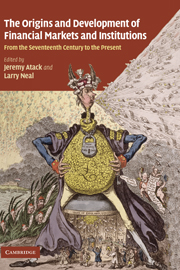 The Origins and Development of Financial Markets and Institutions
The Origins and Development of Financial Markets and Institutions Book contents
- Frontmatter
- Contents
- List of figures
- List of tables
- List of contributors
- Preface and acknowledgments
- 1 Financial innovations and crises: The view backwards from Northern Rock
- 2 An economic explanation of the early Bank of Amsterdam, debasement, bills of exchange and the emergence of the first central bank
- 3 With a view to hold: The emergence of institutional investors on the Amsterdam securities market during the seventeenth and eighteenth centuries
- 4 Was John Law's System a bubble? The Mississippi Bubble revisited
- 5 Sir George Caswall vs. the Duke of Portland: Financial contracts and litigation in the wake of the South Sea Bubble
- 6 The bell jar: Commercial interest rates between two revolutions, 1688–1789
- 7 Comparing the UK and US financial systems, 1790–1830
- 8 Natural experiments in financial reform in the nineteenth century: The Davis and Gallman analysis
- 9 Regulatory changes and the development of the US banking market, 1870–1914: A study of profit rates and risk in national banks
- 10 Anticipating the stock market crash of 1929: The view from the floor of the stock exchange
- 11 The development of “non-traditional” open market operations: Lessons from FDR's silver purchase program
- 12 The interwar shocks to US–Cuban trade relations: A view through sugar company stock price data
- 13 Central bank reaction functions during the inter-war gold standard: A view from the periphery
- 14 When do stock market booms occur? The macroeconomic and policy environments of twentieth century booms
- 15 Lessons from history for the twenty-first century
- Index
- References
15 - Lessons from history for the twenty-first century
Published online by Cambridge University Press: 04 August 2010
- Frontmatter
- Contents
- List of figures
- List of tables
- List of contributors
- Preface and acknowledgments
- 1 Financial innovations and crises: The view backwards from Northern Rock
- 2 An economic explanation of the early Bank of Amsterdam, debasement, bills of exchange and the emergence of the first central bank
- 3 With a view to hold: The emergence of institutional investors on the Amsterdam securities market during the seventeenth and eighteenth centuries
- 4 Was John Law's System a bubble? The Mississippi Bubble revisited
- 5 Sir George Caswall vs. the Duke of Portland: Financial contracts and litigation in the wake of the South Sea Bubble
- 6 The bell jar: Commercial interest rates between two revolutions, 1688–1789
- 7 Comparing the UK and US financial systems, 1790–1830
- 8 Natural experiments in financial reform in the nineteenth century: The Davis and Gallman analysis
- 9 Regulatory changes and the development of the US banking market, 1870–1914: A study of profit rates and risk in national banks
- 10 Anticipating the stock market crash of 1929: The view from the floor of the stock exchange
- 11 The development of “non-traditional” open market operations: Lessons from FDR's silver purchase program
- 12 The interwar shocks to US–Cuban trade relations: A view through sugar company stock price data
- 13 Central bank reaction functions during the inter-war gold standard: A view from the periphery
- 14 When do stock market booms occur? The macroeconomic and policy environments of twentieth century booms
- 15 Lessons from history for the twenty-first century
- Index
- References
Summary
Just before the sub-prime crisis broke in August 2007, an op-ed piece by David Hale in the Wall Street Journal boldly asserted that never in the history of the world has the human race enjoyed such material prosperity. The facts back him up. With a record population of 6.6 billion and an average per capita income of $10,200 in 2006, the world's gross domestic product was still growing at over 5 percent annually in real terms and thus at 2–4 percent per capita. Never has there been so many people living and never has their per capita income been so high. Moreover, never before have there been such bright prospects for the future. Driving this phenomenal achievement, most economists agree, is the rise of trade, starting with the industrialized West after World War II, including the oil producing countries in the 1970s, and finally encompassing the centrally-planned economies of China, India, and the former Soviet Union in the 1990s. Despite occasional tremors in the stock markets of the world, the global economy is awash in liquidity as a result of the unprecedented breadth and depth of prosperity, which has generated high profits in all the countries participating in increased trade.
The resulting savings, Hale argued, as have others, are directed by the increasingly efficient financial markets of the world toward their most efficient investment opportunities. Global finance, in short, provides the basis for continued prosperity.
- Type
- Chapter
- Information
- The Origins and Development of Financial Markets and InstitutionsFrom the Seventeenth Century to the Present, pp. 450 - 464Publisher: Cambridge University PressPrint publication year: 2009
References
- 1
- Cited by


